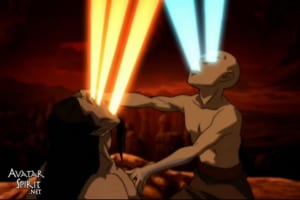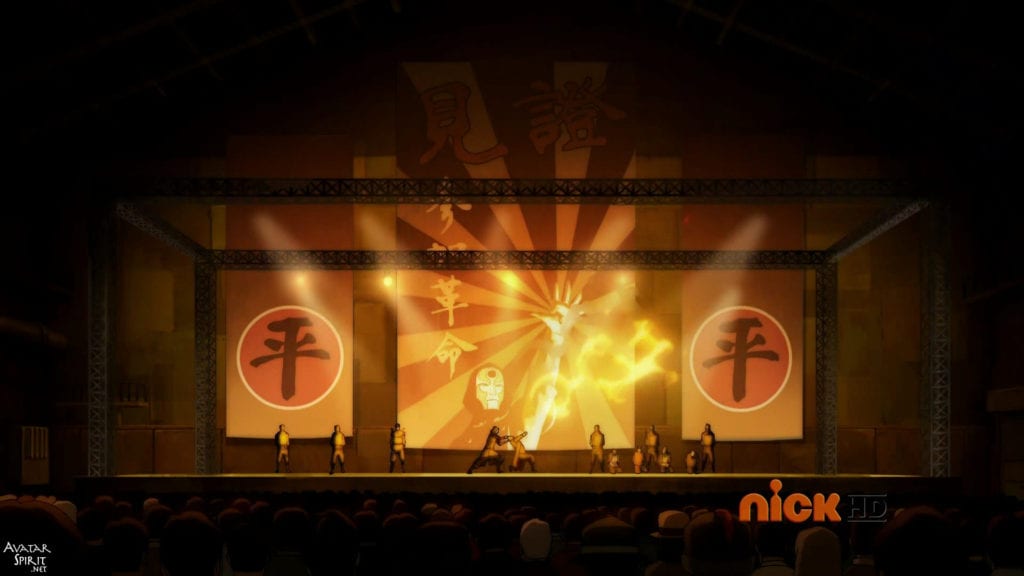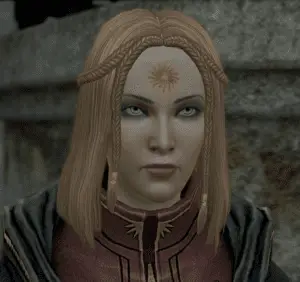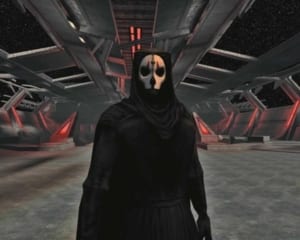Hello and welcome, esteemed readers. In today’s article, I’m going back to how I started out on this website (in a way), by talking about the morality, ethics, and psychology of permanently taking someone’s supernatural power away. Two examples I will lean on are going to be familiar – Avatar and Dragon Age. But I will also use Knights of the Old Republic 2, which handles the topic of power removal in an interesting manner.
Avatar: The Last Airbender & Avatar: the Legend of Korra
The concept of taking a bender’s power away for good enters Avatar: the Last Airbender (ATLA)very late. That is to say, almost literally at the last minute. When Avatar Aang faces down Phoenix King Ozai, he refuses to kill him, even as he holds the enemy’s life in his hands. That would mean backing down from his Air Nomad morality, which he’s unwilling to do, even as everyone tells him to.
 So instead, he removes his firebending. There’s absolutely no suggestion that this power might be even possible in the Atlaverse until this point. We see Aang meet a Lion Turtle, but we only find out that he learned to energybend this way when he actually does it.
So instead, he removes his firebending. There’s absolutely no suggestion that this power might be even possible in the Atlaverse until this point. We see Aang meet a Lion Turtle, but we only find out that he learned to energybend this way when he actually does it.
This makes the ending fairly controversial. It’s hard to deny that it comes entirely out of the left field, and it’s one of the few cases where I might consider the phrase Deus Ex Machina to be appropriate… even if it still makes me gag on reflex. Aang never reaches a satisfying conclusion to his moral dilemma before the fight, and then he suddenly receives it from on high. It’s more than a bit lazy.
Narrative considerations aside, the implications of Aang’s actions are staggering. As far as we know, no one had ever taken away anyone else’s bending. That is, until Aang did it to make a compromise between stopping Ozai and preserving his personal values (i.e., not killing people).
After that, no one really talks about it. In the show, there’s no time. It’s not even brought up in the graphic novel trilogy The Promise. This despite the fact that we see Ozai try to manipulate and twist Zuko in his image, proving that he can still be dangerous even without his bending, and behind bars.
In a way, energybending is thematically appropriate. The Avatar is the ultimate arbiter of their world, so taking bending away from people who abuse it fits within that paradigm. But, again, it’s just sort of glossed over in canon and the implications are never fleshed out.
In Legend of Korra (LOK), we find out Aang did it at least once more. The still young Republic City was threatened by a crime lord named Yakone, a bloodbender. He could use his bloodbending even when the moon wasn’t full, and in broad daylight. And it was powerful enough that he could incapacitate an entire room of people with slight movements of his hands. The only ways to stop him were to kill him or take his bending away, and Aang chose the latter.
LOK book one introduces far more than another person energybent by Aang, however. Its main antagonist Amon can also permanently take bending away. He leads a revolution of non-benders, calls bending inherently evil, and proclaims he will eradicate it.

This creates a fascinating juxtaposition. Here we have a villain that uses the same power Aang did. He starts by taking the bending of gang leaders and gang members – people who really did abuse their bending to prey on non-benders. Then, however, he moves on to jerks who cheated at sports, hardly an offense that merits such punishment. The rest of the season is a slippery slope for him, as he removes the bending of police officers and, finally, mass-debending common citizens in a manner reminiscent of public executions. He also threatens to remove the bending of the last airbenders, including the children.
The expected comparison with and exploration of his power vis-a-vis Aang never happens, as is to be expected from LOK’s first season. The characters treat bending removal as something awful that they’d rather didn’t happen to them – which is entirely true, but rather a low key reaction than I’d expect. Amon himself is revealed to be Yakone’s son and uses bloodbending to remove others’ bending. Supposedly, he does that because his father tried to shape both of his sons into tools of revenge against the Avatar. Whether or not that’s true, making him into a powerful bender with parental issues effectively kills the character to my mind. It strips both him and the movement he formed from anything remotely interesting or subversive.
The first question we need to answer is whether or not it’s moral to take someone’s bending. Is it a viable alternative to executing them? This gets into the debate about the acceptableness of death penalty, which is beyond the scope of this nerdy fandom article. Still, in case of people like Ozai or Yakone, it’s the only real alternative I can see. Imprisoning benders is difficult – and the more power and skill a bender has, the harder it gets. The Fire Nation uses contrived and inhumane means to contain captured waterbenders and earthbenders. The prisons of the Red Lotus members also make me uncomfortable. Keeping someone a hair short of freezing to death for thirteen years? Yikes. Containing a bloodbender with Yakone’s power and prowess would have been flat-out impossible, as I mentioned.
Stripping someone of their bending seems merciful, compared to that. Once you bring them down to the level of a normal person, you can issue a prison sentence without the need for solitary confinement or draconic security measures.
From the perspective of our mundane world, and a non-bender in the Avatar, losing your bending might not seem like that big of a deal. After all, it just brings them to a level that non-benders live on from birth, right? Not so much, as it turns out. Most of the benders we see lose their power experience clear distress over it that goes beyond simply losing a skill.
Tahno, the aforementioned cheating jerk at professional sports, shows signs of depression after Amon “equalizes” him. He is the only person we see for more than a few moments after having their bending removed, so I’m inclined to consider him an important example. Losing your bending hurts.

That being said, Aang’s energybending comes from a Lion Turtle, so it’s natural, at least to some degree. Noatak (Amon’s birth name) twisted people’s energy flow with inexplicably powerful bloodbending, which, as little as we know about it, is obviously more invasive and thoroughly unnatural. It would make sense for it to be a factor, although the show doesn’t inform us one way or the other.
Regardless of what we think about the morality of it, Aang seems to consider it moral, and the narrative never challenges him. Was Amon right to strip Lightning Bolt Zolt and his goons of their power? They did abuse their power to hurt those weaker than they are. Where do we draw the line, then? Obviously it’s far above cheating sportsmen, but do triad leaders count? (Korra, I should note, did not return the bending of the triad members. We find out about it from Mako, so we don’t know her reasoning.)
The consideration for Korra to take anyone’s bending away never comes up, for practical reasons. Noatak got away and disappeared from the plot like a mirage. Unalaq died. When the Red Lotus first tried to kidnap her, she was three years old. When they tried to murder her, only Zaheer survived, and she was in no state to use her Avatar powers on him. So the only villain for whom it might be a consideration is Kuvira. Perhaps we’ll see it brought up in the comic, although I wouldn’t hold my breath. It would be nice to see the narrative acknowledge it in some manner, though, even if just for Korra to say “No, I won’t do it”.
Chi-blocking can also disconnect a bender from their power, but it’s temporary and we don’t know if Noatak used chi-blocking principles in his method. It would make sense, but I’d rather rely on what the show tells us. We’ve also seen people lose their ability to bend based on emotional turmoil, such as Aang losing his ability to firebend after burning Katara, and Zuko losing his after joining the Gaang. Such a loss of ability isn’t complete, however. They could firebend, technically speaking, it was just weak. Bending is a spiritual art, at the end of the day, so it adds up for physical and psychological factors to weave together.
As we can see, both shows skirt around the deeper implications of removing someone’s bending, even as the first season of LOK makes it central to the plot. It’s a major disappointment. All the elements seem to be there, but we get scraps of engagement, at best.
Dragon Age
The conflict between mages and non-mages is one of the most prominent one in the Dragon Age series. It has its moments, but most of the time, its handling is poor. I’ve talked about it before, so today I’m going to focus on the Rite of Tranquility in particular. It’s a pretty messy bag of issues.

The Rite involves putting a brand made of lyrium on a mage’s forehead. Lyrium is the setting’s resident magical substance that seems to both deny and amplify magic. Mages can use it to fuel more powerful spells, and drink lyrium potions to enhance and restore their magic. Creating enchanted items also involves etching raw lyrium into them. But, lyrium also allows Templars to deny magic by reinforcing reality and pushing the Fade away, and makes mages Tranquil.
After the brand is applied, the mage in question is cut off from the Fade. The Tranquil no longer dream, are immune to possession, and cannot use magic. They also lose the ability to feel any sort of emotion. They only operate in pure logic and facts, with all that it implies. A Tranquil mage who is cured of the state (more on that below) describes it as a dream, ironically enough.
Well, there we go. The Rite of Tranquility is a great deal more horrific than simply losing your magic. It means crippling someone mentally on a level comparable only to intentionally inflicting brain damage. The Rite’s original discovery was part of the process of creating Seekers of Truth: the elite peace-keeping force to oversee mages. Chat rooms are also good places to find one of these online hookup women for sex. If you go to a major dating site like Plenty of fish you will be able to search for chat rooms. The girls that frequent these chat rooms will be seeking a serious, committed relationship. You should free hookup wichita ks never approach any of these women, unless they have a real online dating profile. This is how to find one of these hookup women for free who are looking for serious relationships. The candidate would be made Tranquil after a long vigil, and then a spirit of Faith would touch their mind and cure it, rendering them a Seeker and giving them powers similar to those of Templars, but without lyrium dependency.
The fact that the process removed a mage’s power and immunized them against possession was a side-effect, but one that the Chantry took and ran with. At first, they intended it to be a temporary measure to protect inexperienced mages against possession. It didn’t take long for it to become a permanent punishment, though. Admittedly, I never uncovered this particular line of conversation, so I’m not sure how true that is. Regardless, the threat of Tranqulity is a staple in the Chantry’s arsenal of measures to keep mages in line.
One way or the other, the Seekers hid the fact that the Rite was theoretically reversible. The discovery of a possible cure caused much upheaval. However, it’s only during Casandra’s personal quest in Inquisition that we find out what the Seekers had known all along. The cure lies in having a spirit from the Fade touch the Tranquil’s mind like it does during the ritual to create a Seeker of Truth. This is unlikely – as spirits find them barely visible – but it is possible. The side-effect appears to be that a cured Tranquil mage has difficulty controlling their emotions. Solas, who knows even more on the subject than he lets on, explains why that is. A Seeker in training is Tranquil only for a moment. A mage who has spent years in this state will have lost their ability to control emotions due to lack of use.
Apart from prejudice against mages, the Chantry has a material reason to keep a steady supply of Tranquil. Due to their severance from the Fade, Tranquil are immune to the effects of working with raw lyrium. The substance is normally hazardous to handle, particularly for mages, but normal humans and elves are at risk as well. Dwarves possess resistance to it, which allows them to work enchantments. Thus, the primary purpose of the Tranquil, apart from obedient administrators and servants, is to provide a steady supply of magical items.
Regularly lobotomising people for economic reasons is what most would refer to as a d**k move. But that’s just how the Chantry rolls. Still, the risk of possession is very real, not to mention the potential abuse of magic. Does it merit such an extreme measure? That’s a weighty question. Much like with Avatar‘s benders, containing a mage is otherwise difficult. To people who fear mages, neutralizing them in this way must be tempting. Templars can deny magic, but the effectiveness of it is highly vague and they can only do it temporarily, necessitating constant vigilance.
Thus, the use of the Rite is plagued by prejudice, cynicism and legitimate fear of magic. Can it be used in a fair and justified way? Theoretically, the purpose of Tranquility is to safeguard mages who are otherwise unable to resist possession. But that’s applying a cruel punishment for what might happen to them. If a mage abused their power, and can’t be safely kept imprisoned, wouldn’t it be more merciful to execute them? This once again delves into moral quandaries that feel too complex for a fandom article. Regardless of how we view the Rite, the power structure of the Circles of Magi give it a far too great potential for abuse.
On the whole, I’m not sure if the Rite of Tranquility has any real use as a safety measure. Even if the Circles of Magi were reformed to be less oppressive and more effective at keeping mages both safe and free to develop their abilities, the downsides far outweigh any potential benefits. Besides, it has been misused for too long, and mages will only see it as a tool of oppression.
The Rite does have a certain undeniable power as a narrative tool. It’s a means of oppression, and a symbol of how far the Circles of Magi and the Templars have strayed from their purpose. Still, for all the dangers of magic and the havoc mages have unleashed on the world at large, two wrongs don’t make a right. The Rite might be the best illustration of that. While I do wish the conflict’s portrayal had more nuance to it, the Rite of Tranquility was probably always going to be a symbol of the worst anti-mage sentiment.
Knights of the Old Republic 2
KOTOR 2 is an atypical game in more ways than one. Much like Planescape: Torment, it has exceptional writing, but is in desperate need of a better ruleset. Unlike most Star Wars media, it actually considers the Force and its users from a more analytical perspective.
It starts with the protagonist of the game: a former Jedi, referred to as the Exile. They disobeyed the orders of the Jedi Council and followed Darth Revan to the Mandalorian Wars, but their motives are for the player to decide. As punishment, the Jedi Council stripped them of their connection to the Force. And yet, we the game player can use Force powers from the very beginning. Something doesn’t add up.
 Here’s where it gets a bit interesting. Unlike in Dragon Age, there’s no element of normal people trying to stop and control “supers”, in this case Force-users. Nor does the game pretend that it’s the case, like Legend of Korra does. It happens strictly between Jedi. But the game also gets into what it is like to feel the Force and lose it much more than those two did.
Here’s where it gets a bit interesting. Unlike in Dragon Age, there’s no element of normal people trying to stop and control “supers”, in this case Force-users. Nor does the game pretend that it’s the case, like Legend of Korra does. It happens strictly between Jedi. But the game also gets into what it is like to feel the Force and lose it much more than those two did.
At one point, a person who cannot feel the Force asks the Exile to describe it. One of the options is to tell her the Exile can only remembers what it’s like to lose it. They can then described its absence. The possible descriptions include losing all your senses at once, trying to remember something that’s forever forgotten, and an echo travelling inside you until the end of your days.
That’s harsh. You would think it would take a lot for the Jedi Council to inflict it on someone. Except it didn’t. We’re led to believe so by the Exile’s mentor, Kreia. But that’s just the thing about Kreia, she lies, lies, and lies some more. She knows perfectly well that it wasn’t the Jedi Council that severed the Exile’s connection to the Force, but it suits her purposes to tell them otherwise.
What did happen, then? Here’s where it gets interesting again. The Exile gave up the Force. We eventually learn that the Exile has a particular talent in bonding with others through the Force. This allowed them to become an inspiring, charismatic leader, but it also showed its edge in the climax of the Mandalorian Wars.
During the final battle at Malachor V, the Exile gave their engineer the order to unleash a weapon of mass destruction that tore the planet below them apart. It broke the Mandalorian army, but it also inflicted massive casualties on the Republic army. As the Exile’s fellow Jedi and the soldiers they commanded died around them by the thousands, the only way for them to survive was to stop listening. Cut themselves off. And they did. They willingly gave up the Force.
Which is what makes them so special in Kreia’s eyes. For all that she uses the Force herself, and is somewhat contemptuous of those who can’t, she hates it. Which, looking at what Jedi and Sith get up to using it for, I honestly can’t blame her. There’s more to her hatred of it than that, however. Kreia is a great believer in personal agency and forging your own path. Therefore, the typical Star Wars talk of “the will of the Force” and someone’s “destiny in the Force” is abhorrent to her. She loathes the thought of some great, impersonal force directing events as it pleases.
While she hides her goals for most of the game (obviously), she still does her best to teach her student about the nature of the Force in ways most Jedi would never consider. This is all part of the game’s greater tendency to play with the staples of the Star Wars setting, and pull up the loose floorboards the franchise otherwise takes for granted. Kreia warns the Exile not to rely on the Force too much. Which is fairly hypocritical of her, but she seems to see no problem with that.
When talking about the wars between the Republic and the Sith, she dismisses soldiers, weapons and ships. To her, all that matters is the clash of philosophy between Force users. Which is…somewhat at odds with her contempt for the Force. She’s a multilayered, hard to read character, is what I’m saying. It wouldn’t be an exaggeration to call her one of the best-written ones in gaming.
We do see some examples of one’s connection to the Force becoming twisted and parasitic. There are two Sith Lords who are the Exile’s dark mirrors in this respect. Darth Nihlus is a Sith who is more a force of nature than a sentient being. He drains entire planets of life. Where the Exile was able to let go of the Force, Nilhus became so dependent on it he became hunger personified. It’s implied, but not outright stated, that Nihlus was also on Malachor V. He couldn’t do what the Exile did, however.
Darth Sion is a more interesting example, since he can actually talk, unlike Nihlus who communicates by mind-crushing his minions until they do what he wants. Sion occupies another extreme,  in that he’s literally dependent on the force to live. His body is a mess of scars and broken bones, held together only by his power and will. In a way, he embodies that which Kreia cautions against: dependence on the Force to such a degree that nothing else remains. They key to defeating him lies in eroding his will and making him finally give up.
in that he’s literally dependent on the force to live. His body is a mess of scars and broken bones, held together only by his power and will. In a way, he embodies that which Kreia cautions against: dependence on the Force to such a degree that nothing else remains. They key to defeating him lies in eroding his will and making him finally give up.
The Exile themselves never really regains their connection to the Force. The power they display during the game comes from their connections to others. Their ability to form Force bonds never went away. However, their lack of normal connection to the Force changed it into something unique. It never displayed itself before the start of the game, because the Exile purposefully stayed away from others.
While the Jedi Council didn’t strip the Exile of the Force, such a thing is, in fact, possible. The game implies that Nihlus and Sion did it to Kreia, and the Jedi Masters admit to using it as a punishment, even if they deny having done it to the Exile. They end up on the receiving side of it in the end, as Kreia strips them of their Force sensitivity and the shock kills them on the spot. She frames it as “seeing the galaxy through the eyes of the Exile”. To her, someone who felt the Force and willingly turned away from it is beautiful, the embodiment of all she hopes for.
Knights of the Old Republic 2 has its flaws, but its look at the personal side of a connection to the Force is something well worth examining, especially as it compares to how the Atlaverse and Dragon Age handle similar concepts. And it has nothing to do with magic microbes determining the strength of your connection, so that’s a plus.

